This post may contain affiliate links. This just means I may receive a small commission at no extra cost to you for helping them promote their product or service. I don’t endorse any services I don’t personally use or recommend.
Few people visit the remote recesses of the Amazon. But ask those who have and most will say they have visited Iquitos. It’s without a doubt the most popular Amazon expedition destination in South America. But as with any town tainted by mass tourism, it can be more and more difficult to find the “true” Amazonas experience. Instead of searching the virgin jungle for wildlife you’ll most likely get roped into a tour of “monkey island”, hold a pet sloth, and witness a “ceremony” (for your benefit) of traditional Amazonian dress and dancing. It’s really all just a grand performance. But in Peru, you have other options. Tambopata National Reserve offers more low-key & authentic Amazonas excursions.
I’ve been to the Amazon before. So perhaps, I’m a little wildlife spoiled. We spent the night under the stars on a floating hammock in the most remote recesses (accessible to tourists) of the Colombian Amazon near Leticia. This time around we weren’t looking to downgrade to a more traditional tour in Tambopata. We still wanted a little bit of adventure.

We didn’t necessarily find it. But we did find some great wildlife excursions that didn’t feel overwhelmingly touristy and think that Tambopata is a better option than Iquitos for getting a feel of the Peruvian Amazon.
But again, if you want my favorite Amazon experience. Head to Leticia, Colombia.
Your Complete Guide to Visiting Tambopata National Reserve
Here’s everything you need to know to plan a successful expedition into the Amazon rainforest.
Getting to Tambopata National Reserve
You can’t get to Tambopata National Reserve without first going through Puerto Maldonado. There are essentially 2 ways to reach Puerto Maldonado. By air or by bus.
We chose to arrive by bus via Cusco for several reasons.
- It was much cheaper.
- All flights to Puerto Maldonado come from Lima & it seemed far too roundabout to have a stopover in the wrong direction.
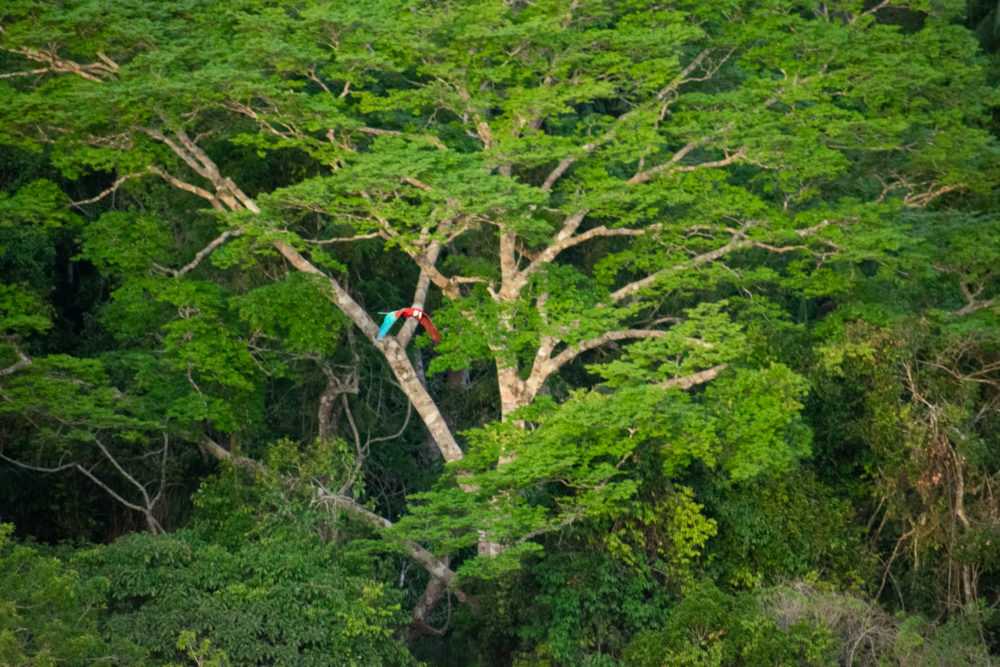
The bus to Puerto Maldonado from Cusco costs 92 soles per person (typically) on Cruz Del Sur (I recommend booking on their website) and lasts 10 hours. It’s a windy rough highway and reaches an elevation of more than 15,000 feet.
Hot tip: Cruz Del Sur does this weird thing where a select few of the second-level seats are a fraction of the price. It’s real & the seats are totally normal- so don’t be deterred. Sometimes they don’t let you purchase them for some unknown reason BUT we snagged my Amazonas route seats for only 20 soles each way.
If you haven’t yet ridden the buses in South America- you’re in for a treat. Unlike Asia’s torturously small seats these seats each have their own television equipped with movies (albeit in Spanish) and recline almost completely for comfortable snoozing.
For the return trip, the Puerto Maldonado Bus Station is surprisingly huge & be warned you’ll have to pay a small exit fee (3.5 soles) before you board your outbound bus.
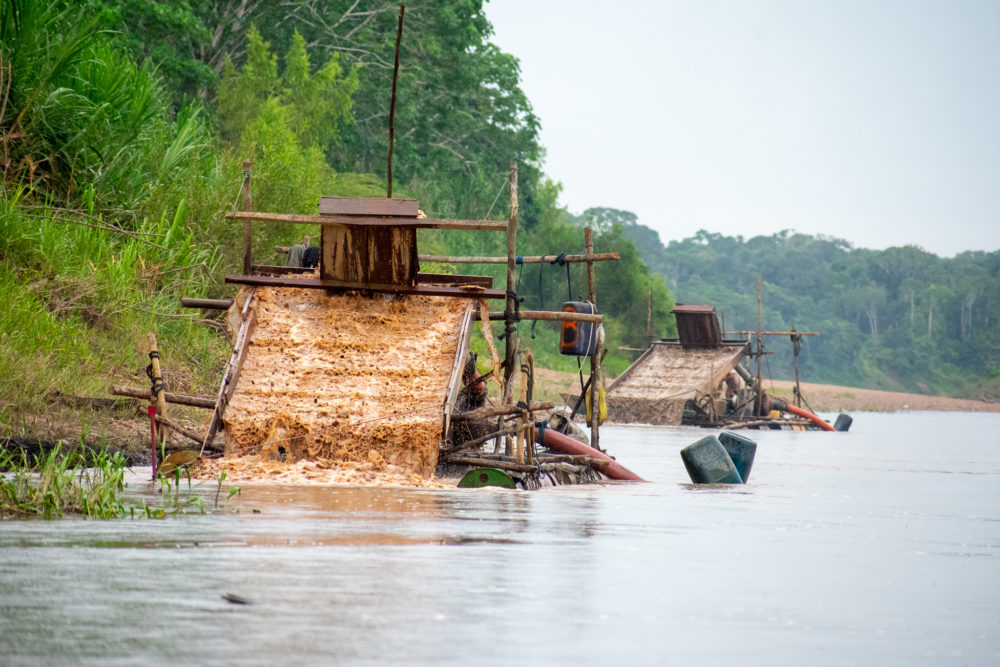
For those of you who fly by the seat of your pants (my kind of people), you can score a deal on numerous unlisted buses nighttime AND DAYTIME from the bus station itself. I couldn’t find any day buses online from Puerto Maldonado to Cusco but they existed- & this drive is known for being spectacularly scenic.
Flights to and from the Amazonas region can be expensive & pretty much exclusively operate from Lima. But if you’re short on time or dead set on flying this is an option.
The City of Puerto Maldonado
You’re first stop in the Amazon. Puerto Maldonado is nothing like the remote towns of Iquitos or Leticia, Colombia. For starters, you can drive here. Secondly, it’s rather large. There was tons of places to eat, shop, and local markets in remote streets far from the town center. I didn’t necessarily WANT to spend more time in the city but you could.
I won’t sit here and pretend my 36 hours in the city make me any kind of an expert. BUT we did unearth some really great food spots to fuel up before your Amazon tour.
Here’s what we can recommend in Puerto Maldonado.
Your Guesthouse: Hospedaje Semaniego.
I recommend staying at least one night in Puerto Maldonado itself. This homestay is one of the cheapest in town and was surprisingly comfortable. They also let us keep our bags there free of charge during our Amazon trip.
Just don’t expect any hot showers in the Amazon region.
This restaurant either didn’t have a name or I just somehow failed to see it but the yellow restaurant across the street from the guesthouse came alive at dinner time. It served super cheap delicious-looking local food and I wish we had found it sooner.
La Semilla for breakfast.
This teeny little hippy haven makes a killer breakfast. 12 soles for fresh papaya juice, fresh-baked bread with jam and butter, and an omelet or ham and egg scramble. The upstairs offers views of a large tree that is sometimes home to a resident sloth. Also, the lunch special with sandwiches, salad, and fresh juice is worth the 15 soles. & quinoa bowls.
This place is just good.
Compartir- Sanucheria Criolla for juice, sandwiches, and a view.
The juice here is to die for. I’m a big fan of the mango.
El Hornito Pizzeria for decent pizza and sangria.
As any traveler knows, pizza is usually a disappointment outside of the USA or Europe. But on a rare occasion, you unearth a place that makes a decent pizza. This place does that & makes phenomenal Peruvian sangria to top it off.
The best food we had in Peru we enjoyed on a street food tour in Lima and surprisingly enough…on the Inca Trail with Alpaca Expeditions!
What to see in Tambopata National Reserve?
Why venture so far East in the first place? What does the Amazonas region & this reserve, in particular, have to offer? Well first, you have to decide if you have time for Chuncho, Lake Sandoval, or both. This is the wildlife you’ll find in Chuncho.
Wild Macaw Salt Lick
This is the number one reason to visit the particular patch of rainforest.

Every morning hundreds of Scarlett, Blue, and Red/Green Macaws flock to the orange clay cliffsides of the Amazon river in this particular region to add sodium and other vital minerals to their diet.
If you’re interested in seeing parrots this is the place to do it.
Jaguars, Tapir, Howler Monkey, Spider Monkey, Capybara.
These are the more elusive mammals you’ll have a chance at spotting in the jungle. The longer you stay and the deeper into the rainforest you venture the more likely you’ll spot them.
An array of impressive tropical birds. From toucans to turkeys.
I was most impressed with the diverse birdlife in the jungle. Each day we saw a handful of new colorful birds.
A diverse insect & plant life.
Maybe not the most exciting attraction BUT it is interesting. You’ll see most of the insects on your night walks through the rainforest.
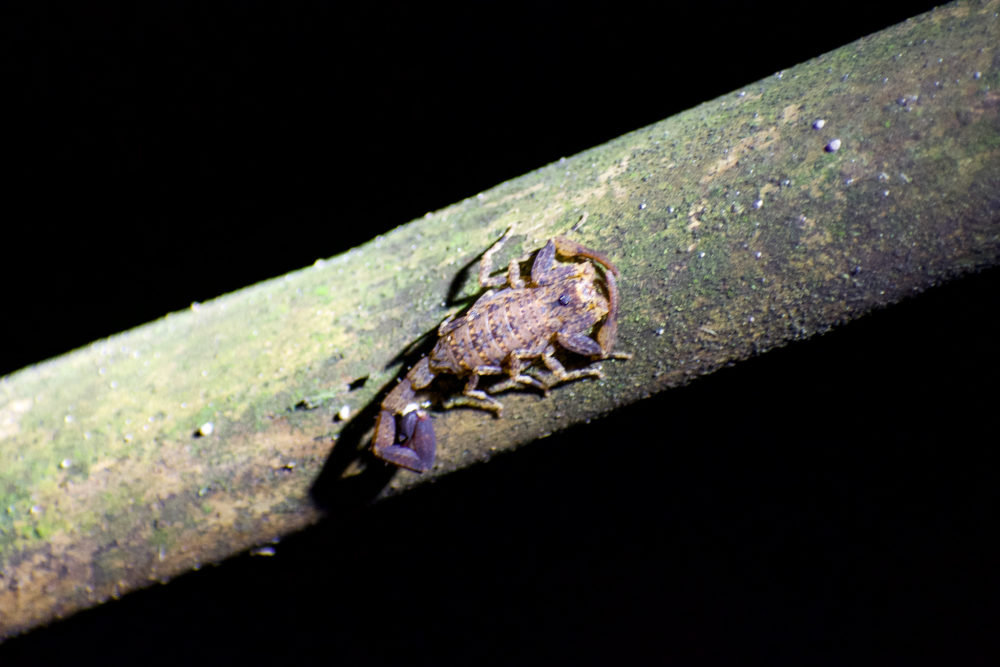


Sandoval Lake.
This lake is several hours upriver in the other direction from the Macaw salt licks. They can’t really be done together. The major benefit to this lake is the chance to spot large river otters. But you don’t get the parrots. Otherwise, the wildlife is basically the same.
If you are interested in a trip to Sandoval Lake as well, plan to stay for at least 5 nights in the Amazon. Then you can split them between the two regions.
Should you Book Tambopata National Reserve Excursions in Advance?
No.
Booking in advance only ensures you’ll pay 4x the amount.
I recommend arriving one full day before you would like to embark on an Amazon excursion. Head straight to the main square/put Tambopata Jungle Tours into your GPS. This will lead you to an entire alleyway filled with rainforest tour agencies. They all offer- more or less- the same itineraries at various prices. Arrive early enough and you can even depart that same day.
When is the best time to visit Tambopata National Reserve?
May. According to our guide who lives here year-round. The jungle comes alive. This is the month right after the rainy season when the animals are most active and the rainforest is its deepest green.
Other good months are June, September, & October.
The absolute worst months for spotting wildlife in Tambopata National Reserve are July/August due to the heat & February because of the torrential rains.
We visited this rainforest during November & had previously experienced the flooded forest floor of the Amazon during February in Leticia, Colombia. It was a very different experience.
Spend 3 Days/2 Nights in a Jungle Lodge
We chose the 3D/2N itinerary in Chuncho with Tambopata Jungle Tours for 650 soles per person ($165). We decided to skip Sandoval Lake because it seemed similar to the Amazon experience we had already had in Leticia (& it is far more popular- more people = less wildlife).

Like the others this includes all your meals, water, and stay in a comfortable rainforest lodge as well as a fishing trip (uneventful), Kayak down the Amazon (unnecessary), guided daytime and nighttime walks through the forest (exceptional), and of course, a morning marveling at the macaw salt licks.
So why did we choose this specific tour?
Because we wanted to maximize our wildlife viewing potential while prioritizing the Macaw salt lick. Because that’s really what makes this particular patch of rainforest unique. It also fit our narrow window of time that we had allowed ourselves to explore in the Amazon. Hindsight- we wish we had a full week. We always wish we had just a little more.
Another benefit to this particular company is that they own two large lodges- one about 2 hours by boat and car from Puerto Maldonado (that we stayed in) & another much deeper in the jungle that takes 4-5 hours from Puerto Maldonado to reach. This lodge is within the vast virgin rainforest. I’ll talk about it later.
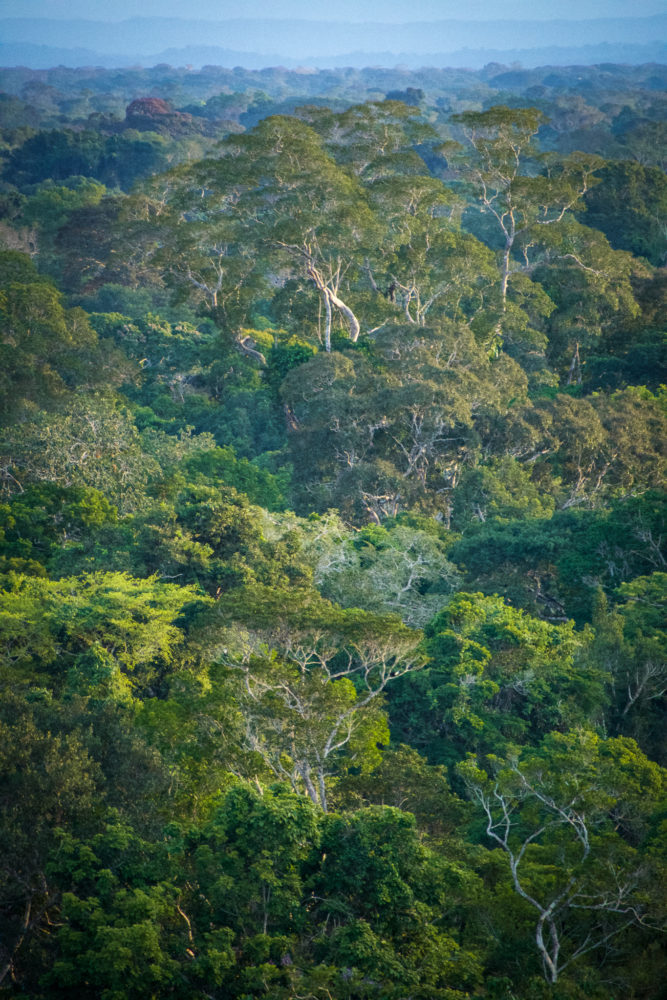

For the basic lodge, Tambopata Jungle tours constructed a 50-meter tall viewing tower (the tallest of all the lodges) for prime viewing of the canopy.
It’s incredible. Wobbly at times. But absolutely spectacular.
Truthfully, most of the lodges offer the same attractions so this slight difference (and attractively low price) made this the right choice for us.
What to Bring.
- Lightweight & Loose Fitting clothes. In light colors, if you can. Bright colors scare the parrots and mosquitos gravitate toward dark colors.
- Camera with a Zoom Lens. You don’t actually get THAT close to the parrots. You’ll need a good zoom.
- Insect repellent. Try to buy it IN Peru or bring a repellent with a high deet percentage.
- Sun Hat. Sunscreen. For kayaking and hiking in the daytime.
- Hiking Boots. Closed-toed shoes only in the jungle. Everything can kill you in there. Snakes, wasps, Bullet Ants, scorpions, tarantulas- you don’t want to step on any of them.
- Rain Jacket. It is the rainforest after all.
- Cash for beer and tips. Beer is 15 soles for a large bottle & tips are up to you.
- Books/podcasts/deck of cards. Something to keep you entertained during your down time. This is my list of favorite non-fiction travel books.
- Water Bottle. I use LifeStraw. It has saved us over $1,000 in several years of travel.
- Swimsuit. On the last day, I took a little dip in the Amazon. Because how many times in your life are you gonna get to do that. This is my favorite travel swimsuit.
- Itch cream, ibuprofen, Benadryl. The essentials.
Not Short on Time? Visit the Virgin Rainforest.
Now let’s talk about that other lodge I mentioned. The virgin forest lodge. This is the dream. But unfortunately, not a soul we talked to mentioned it as a possibility until we were already in the jungle on our excursion. It’s not well publicized by the tour companies.

It’s definitely significantly better suited to spotting wildlife. In the region of our lodge, there were illegal miners searching for gold and enough people working on the river that I feel like most of the big wildlife is scared deeper into the forest. It just wasn’t quite as remote as we wanted.
This tour requires a minimum of 5 days but 7 is better. From what we understand you’ll spend 2 days camping and then the rest in the lodge deep in the wilderness. It’s where the serious photographers and wildlife buffs go.
We didn’t do this tour. But we would next time. Theoretically. We heard a 7-day stint can run up to $1,200 per person. But if you can get a deal this is your best chance at seeing the most wildlife & all the best the rainforest has to offer. Just ask for the lodge in the virgin rainforest.
Let me know if you visit & how much your tour cost!


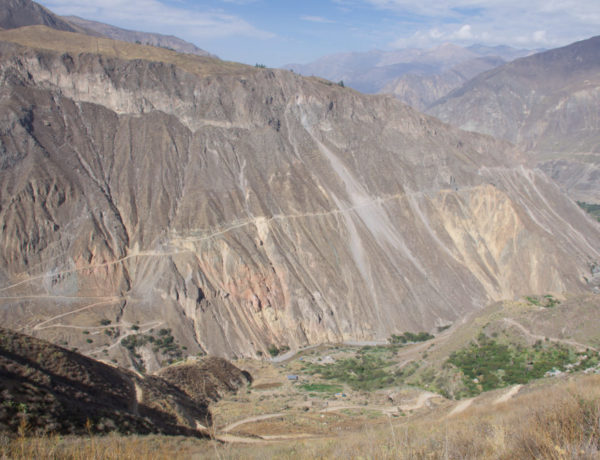




4 Comments
Sasha
March 12, 2024 at 9:44 pmThanks a lot for the detailed overview, really helpful for planning! Looks like the information on virgin forest lodge is limited in the web – any chance you recall which travel agency would provide it? Or is it something to ask in Puerto Maldonado?
admin
March 14, 2024 at 2:18 pmThe best way is to go to the main square in Puerto Maldonado and arrange for yourself at one of the many tourism shops! This is the way to get the best price and decide exactly what activities you want to do in the jungle.
San
April 30, 2024 at 7:44 pmHi, What was the exact name of the lodge you stayed and how far it was from the Cuncho lick? Also how long was your boat trip and car trip from the town of PM to get to this lodge?
Ideally, it will help if you can please have a map of the area and where you stayed during this trip. Thank you.
admin
May 5, 2024 at 8:41 amHi! The lodge didn’t have a specific name as you couldn’t book it without the tour company listed in this blog post. It was about 2 hours by river from the lick itself so you leave very early in the morning. Getting to the lodge itself took around 4 hours with boat and car from the city.